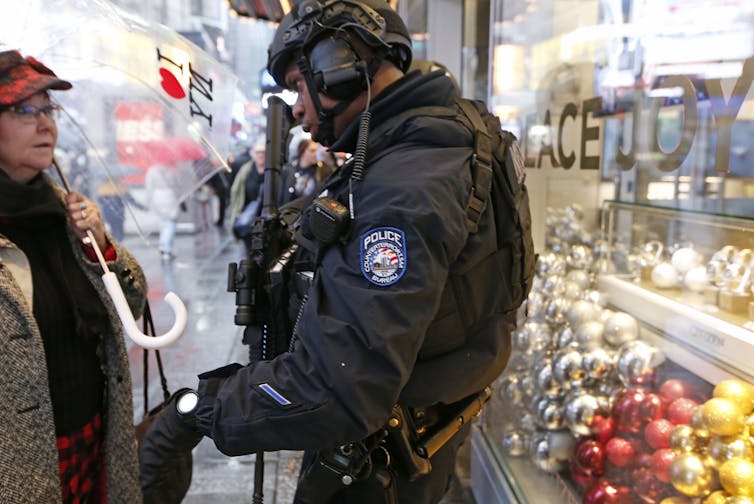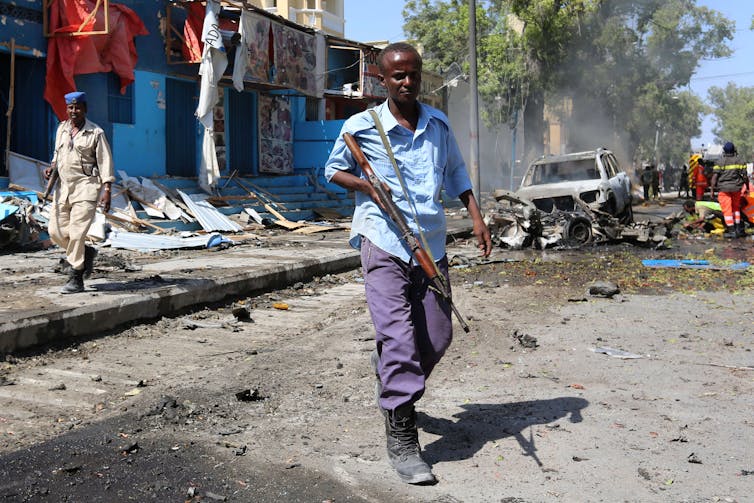what is the us doing to stop terrorism
A January 2017 Pew survey showed that Americans charge per unit terrorism as the height priority for the Trump administration and Congress. They put the upshot ahead of the economy, pedagogy, jobs and health intendance costs.
For the by 12 years every bit Managing director of the National Consortium for the Written report of Terrorism and Responses to Terrorism, I have worked with colleagues to improve understanding of terrorism by studying its causes and consequences. One of our largest and most extensive projects has involved compiling all terrorist attacks worldwide since 1970 into the Global Terrorism Database (GTD).
Based on this piece of work, six issues stand out to me as major challenges for developing effective policy on countering terrorism.
#1: Terrorism is rare

For virtually places and times, terrorism is an incredibly rare event.
In many recent years, the United states has experienced fewer than 25 terrorist attacks. At the same fourth dimension, there are about thirteen,000 homicides and 360,000 robberies every twelvemonth in the Us. In recent years, worldwide traffic accidents accept claimed the lives of roughly 100 times more people than those killed by terrorists.
Fifty-fifty important groups like al-Qaida have committed relatively few attacks. The GTD shows al-Qaida has been responsible for only 59 attacks over its entire lifespan and only 5 attacks since 2008. The fact that terrorism is so rare ways that we have express ability to do statistical analysis and reach general policy conclusions.
#2: Mass attacks are rarer notwithstanding
While terrorism is rare, mass prey attacks are fifty-fifty rarer.
Over half of all terrorist attacks in the GTD since 1970 included no fatalities. The GTD identifies but 17 attacks from around the globe that claimed more than 300 lives. Of the more than 156,000 terrorist attacks in the GTD, the coordinated attack of ix/11, which took the lives of nearly 3,000 people, is nonetheless the deadliest attack in modern history.

Apart from nine/11 no attack on the U.Southward. homeland in half a century has claimed the lives of more than than 200 people. The closest was the 168 victims of the Oklahoma City bombing in 1995, orchestrated by Timothy McVeigh.
Considering a few mortiferous but highly unusual attacks attract so much concern, terrorism policies tend to be based on extremely rare and unusual events rather than the thousands of more common but less spectacular ones. In my stance, policies based on farthermost outliers can have serious and perhaps unforeseen implications.
#3. Prevention is improving
A growing number of terrorist attacks — especially in the United states and Western Europe — are being foiled every bit plots. This is plain proficient news in terms of protecting citizens and saving lives. Another upshot is that policymakers accept diminishing information on the actual seriousness of threats because the attackers are being stopped before their plans are actualized.

#4. Terrorist groups are not all alike
Terrorist organizations are extremely various which makes generalizations even more difficult.
When nearly people think of terrorist groups an paradigm comes to heed of some well-organized and highly-publicized entity like the Islamic State or al Shabaab. In reality, it'south hard to generalize about terrorist groups. On one extreme are individuals who accept no recognized links to a terrorist organization — then-called lone wolves. On the other end of the spectrum are highly organized groups that persist over time, have a well-defined chain of command and a stable leadership. In between are loosely continued minor groups as well as shadowy networks — for example, Neo Nazis or radical Islamists. All of these disparate entities are typically in a state of flux. Modify is abiding; stability rare.
Of the more than ii,300 unique terrorist organizations identified in the GTD since 1970, nearly seventy percentage had a life span of less than a twelvemonth. Terrorist organizations are a bit like business startups: Most are gone within the first year of operation. Information technology is ane thing to respond to a well-organized group, with articulate leadership, a concatenation of command and an identifiable membership. But responses are much more complicated when at that place is no key organization, no identifiable leader or merely an ill-defined group of individuals with varying connections and commitments undergoing constant alter.
#5. Assigning responsibleness is tough
Attributing responsibility for a terrorist assail is ofttimes ambiguous or impossible.
Data from the GTD shows that no terrorist group can be assigned responsibleness in most threescore percent of the thousands of attacks that occurred worldwide since 1970. Attacks may be launched past loners who are working more or less independently of any specific grouping. In other cases, more than i group may claim the attack. Or a group may claim responsibility when in reality it had no connection to the attack, or a group may claim incorrectly that another group was accountable.
Analysts may just never accept enough information to reach a conclusion or to distinguish between competing accounts. Following a terrorist set on, governments are nether enormous pressure to identify the guilty political party and offer a swift response. But how tin can officials punish wrongdoers and deter others from engaging in terrorist attacks when they never know for sure who the culprit is?
#6: We're still developing strategy
Finally, while researchers are making great progress in developing a framework for the scientific study of terrorism, the report of counter terrorism is withal in its infancy. While it is difficult to become an accurate grasp of terrorist threats, it is fifty-fifty harder to evaluate the strategies used past governments to counter terrorism. Governments are extremely secretive most their counter terrorism policies and strategies. And certainly there is nothing close to a worldwide database on counter terrorism strategies and their effectiveness.
Making ameliorate policy
The terrorist threat in the Us is episodic, sporadic and inconsistent. Too often policies react to fearfulness rather than real threat estimates. For example, in that location is no empirical evidence to back up President Trump'southward recent decision to ban citizens of 6 majority-Muslim countries from travel to the U.S. in the proper name of preventing terrorist infiltration. Trump'south executive order of March 2017 would halt travel from Islamic republic of iran, Great socialist people's libyan arab jamahiriya, Somalia, Syria and Yemen. But no one from these countries has been involved in a fatal terrorist attack in the U.s.a. since 9/11.
What'south more, these policies are difficult to undo. For case, the USA Patriot Act, passed in the chaotic backwash of 9/eleven, was designed to "deter and punish terrorist acts," but was quickly expanded by law enforcement officials to prosecute drug offenses and other non-terrorist crimes. Such an expansion raises concerns about privacy and the power of the federal government.
Successful policy requires collecting the best information possible, honestly accessing it and avoiding over reaction.
Source: https://theconversation.com/6-reasons-why-stopping-worldwide-terrorism-is-so-challenging-70626
0 Response to "what is the us doing to stop terrorism"
Post a Comment